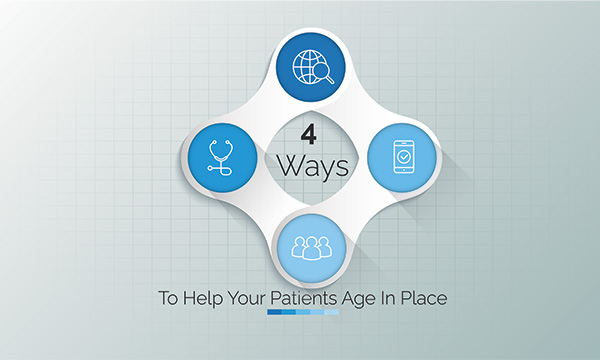Policymakers, care providers, families, and even older adults themselves have long acknowledged the value and benefits of aging in place. The ability to age in the comfort of one’s home and the same community has improved the quality of life of older adults, which positively impacts their physical health as well.
Many seniors prefer to receive care at home or what is commonly referred to as aging in place. The Center for Disease Control and Prevention defined aging in place as “the ability to live in one’s own home and community safely, independently, and comfortably, regardless of age, income, or ability level.” Despite our best efforts like a healthy diet, regular exercise, and relevant social activities, aging takes its toll on our minds and bodies.
Other than avoiding contracting a serious illness, a likely occurrence in most senior living facilities, the cost savings involved in living at home is also another factor in why many older adults and their families prefer the aging in place setup. The challenge now is for providers to ensure the health of their senior patients who opted to stay at home and remain independent.
What makes aging in place difficult?
The most recent data reports that the number of Americans aged 65 and above totals 54.1 million in 2019. This is roughly 16.5% of the population or 1 in 7 Americans. This number will continue to increase with a projected population of 85.7 million by the year 2050, which comprises 20% of the population. With such a significant number potentially needing geriatric care, the challenge is for physicians to safeguard and improve the health as well as the well-being of the older population.Aging brings about these primary health issues:
1. Physical and Cognitive Impairment
Older adults are more prone to illnesses, injuries from falls, or disability. Many factors are at play here like wear and tear, lifestyle, or complications from a chronic condition. Providers need to educate their patients and their families on planning for the eventuality of an older relative falling or of being forgetful as an early sign of dementia. How will the family be notified and who will check on the patient are the most common questions that need to be resolved. The goal is for the patient to have access to receiving support when there is an injury or an illness,2. Multiple Chronic Conditions
Older adults are more likely to have two or more chronic health conditions, the more common of which are heart disease, COPD, osteoarthritis, diabetes, heart failure, atrial fibrillation, and dementia. This would mean more self-management of their own conditions like keeping up with their medications, monitoring for symptoms, and taking the necessary action when needed like a doctor’s consultation. Nowadays, older patients are relying more on virtual consultations with providers increasingly offering virtual care services.How to help patients age in place?
Providers have the venue and opportunity to educate their patients, their families, and caregivers on how to ensure older patients can have the option of aging in place and receiving appropriate care. Here’s what providers should be discussing with their elderly patients:1. Finding the right location.
Aging in place does not necessarily mean the place where the older adult has been staying or living. It could be a new location that can easily be home. Hence, finding the right location to age in place is crucial with the chief consideration of having easy access to everyone and everything that is important. Older patients should have the means for meaningful social interaction, outdoor activities, exercise, balanced meals, and favorite pastimes. A senior living community has its advantages but so would a mixed-age neighborhood, which could offer older adults a diversity of social activities and more support.2. Being proactive and addressing health concerns.
Older adults will eventually have mobility issues that could lead to social isolation and even depression. These factors could negatively impact the patient’s health. It may be beneficial to ask patients to seek out geriatric health information so that some health concerns can be addressed before they even manifest. Family members or caregivers should know what symptoms to look out for and what lifestyle changes to implement. Initially, older patients will not be inclined to make any lifestyle changes, but small victories are possible with consistent dialogue with providers they trust and whom they feel comfortable with. For instance, a weight loss could be an indication that the older patient is no longer able to cook a healthy meal. Family members may consider Meals-on-Wheels or any other option to provide the nutritional support older patients need.3. Get innovative with technology solutions.
Covid has pushed virtual care into the limelight and providers have relied on technology to care for their elderly chronic care patients. Physicians are now leveraging virtual care programs like Remote Patient Monitoring (RPM) and Chronic Care Management (CCM) to deliver the care their patients need. RPM uses devices that can capture real-time data on a patient’s health status and transmit them to a patient portal for review by a clinician. Any abnormal measurements can be immediately detected and acted upon. Meanwhile, CCM provides multiple touchpoints in between office visits to ensure the patients are complying with their care plans and adhering to their medications. Both virtual care services have been successful in preventing further escalations that warrant a trip to the ER or additional hospitalization. There is now a new generation of tech tools to help older patients. The following are a few samples of how technology has offered its solutions to aging in place:- Accelerometers that detect falls without the patient pushing a button.
- Home sensors that track activity patterns and send alerts to family members when there is a detected significant change.
- Easy access to digital tools may be a poor substitute for in-person contact, but internet use among older patients led to a lower incidence of depression. Moreover, there are now new apps and services that are more user-friendly even for the less tech-savvy and allow older people to connect to people easily albeit virtually.
- Tech-enhanced healthcare management tools are aplenty that could send reminders to patients to take their medication or manage their appointment schedules.



